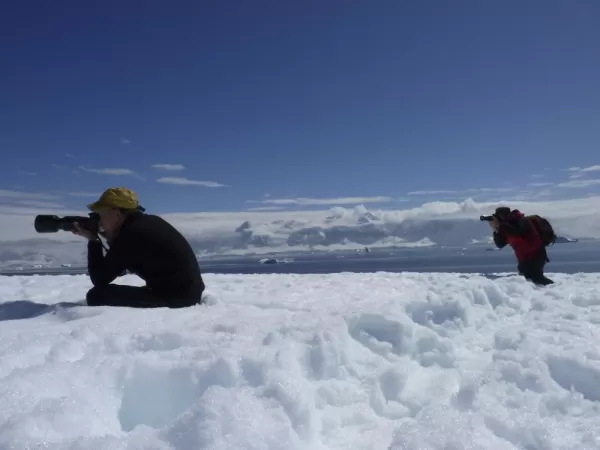It's almost impossible to describe the feeling of arriving in Antarctica. Spotting your first iceberg and taking a deep breath of some of the most fresh, crisp air on earth is an experience that will stay with you forever.
Your experienced expedition team, who have made countless journeys to this area in partnership with the team of photography experts, will use their expertise to design your voyage from day to day, getting you in the best position based on the prevailing weather, ice conditions, and wildlife opportunities. Flexibility is key on an Antarctic expedition, especially a photography expedition. Rest assured that if a wildlife event presents itself or the light hits a glacier just right; the team will do what they can to allow you more time to capture it, provided it is possible and safe to do so!
Once you arrive, the Antarctic Peninsula and the South Shetland Islands are yours to explore, and you have many choices available. You generally make landings or Zodiac excursions twice a day, and the timings will depend on what the day brings you. You are planning to make some landings at sunrise and sunset where/when possible, but with approximately 18-24 hours of daylight this far south, these sunrise/sunset landings are rewarding but quite challenging!
Rug up before joining Zodiac cruises along spectacular ice cliffs or among grounded icebergs, keeping watch for whales, seals, and porpoising penguins. You have been known to have longer Zodiac excursions than originally planned... sometimes you are just presented with a special moment that cannot be missed. One can never know what wonders Mother Nature will serve up! And that is all part of the beauty and the fun of an expedition to the Antarctic. Keep an ear out for the creak and deep rumble of glaciers as they carve from summit to sea. With the engine turned off, take a quiet moment to experience the wonder of this incredible white continent.
The Zodiac excursions are a major part of the expedition, and on this voyage, you have reduced the passenger numbers on the voyage and in the Zodiacs. This will allow your photographers to maneuver around the Zodiacs to easily capture their subject matter and allow sufficient room for their gear. Zodiacs will also transport you from the ship to land, where you can visit penguin rookeries, discover historic huts, and explore some favorite spots along the peninsula.
While ashore, the expeditioners will choose how they would like to explore that site. Quite often, one of the options will be to hike up to a vantage point with mountains towering overhead and ice-speckled oceans below. The light can vary dramatically depending on the day's weather, but the ridgeline's view never disappoints. If you focus on the wildlife, you may wander along pebbly beaches where you are likely to find a variety of penguins (mainly Gentoo), seals, and birds in this area. Occasionally, you may capture a leopard seal coming close to shore to find a snack. Whichever option you choose, the team will be with you every step of the way.
In addition to Zodiac cruises and shore excursions, you may ship cruise some narrow, dramatic straits separating offshore islands from the mainland or linger in scenic bays to watch whales traveling or feeding.
This is a great time to enjoy the Glass Atrium Lounge inside the bow or the Observation Lounge, featuring huge windows and superb views. The bridge will be opened at the Captain's discretion, giving the photographers a different perspective of the running of an expedition through these waters. Of course, the tradition of the polar plunge, where those who dare to will have the chance to fully immerse themselves in polar waters - conditions permitting!
When you aren't exploring by foot or Zodiac, join as many lectures and workshops as possible. Various photography-focused workshops also offer lectures from the expedition team of naturalists, historians, marine biologists, etc.
Note: The scheduler, where Antarctic operators book their dates and sites, opens closer to departure. Once your sites are booked, the team will be able to provide more information on places you are likely to visit on this voyage. Keeping in mind that this is an expedition and there is always an element of flexibility.



























